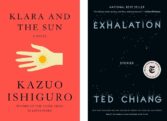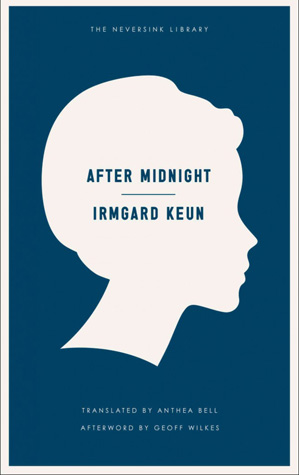
by by Margaret Kolb

Published by Melville House, 2011 | 169 pages
“A writer in the act of writing must fear neither his own words nor anything else in the world. A writer who is afraid is no true writer.” By the time she wrote this in 1937, Irmgard Keun knew a lot about writing and fear. Born in Berlin in 1905 and initially trained as an actress, Keun wrote a series of brilliant novels in the early 1930s depicting the sex lives and career struggles of young urban women in Germany. The Nazis, however, were less impressed by her work. Keun’s novels were withdrawn from circulation and publically burnt, though she bravely – perhaps ironically – sued the Gestapo for loss of earnings. Refused membership of the Reich Chamber of Literature, a necessary condition for publication under the Nazis, Keun left Germany in 1936, spending the next four years in a host of European countries and the United States. It was during this exile that she wrote After Midnight, an intense and darkly comic portrait of life under Nazism.
The novel is set in Frankfurt in the mid-1930s. Nineteen year old Susanne Moder – or Sanna as she prefers to be called – is our narrator, a woman surrounded by sexual and political intrigues. Though she guides us through a series of bars, cafés and restaurants accompanied by her glamorous best friend, Sanna is often left desperately alone in the dark corners of a room or out on the street. Several incidents of anti-Semitism occur – notably, a newspaper seller who believes there are secret Jewish signals imprinted on German coins and that he himself has invented a twig that can detect Jews – while Frankfurt is filled with literal warning signs, banning or defaming Jews. Sanna’s ironic, conversational narrative combines acerbic observations about Nazism with a certain naivety. She claims, for instance, to be rather perplexed by the Nazi’s racial categories – admitting, “I can never get the hang of these labels” – but her confusion only confirms the utter absurdity of the era’s politics.
This is a world of petty, yet deeply claustrophobic, surveillance. An atmosphere of fear, compliance and uncertainty prevails. Frankfurt’s citizens denounce and blackmail their neighbours in order to gain the slightest advantage. A single contrary comment may be offered as evidence of political perversity. Sanna herself gets into trouble with the Gestapo for criticising one of Hermann Göring’s speeches – “I always got the feeling he was telling me off,” she says. Whispers of torture and concentration camps are beginning to be heard.
The flipside of Fascist surveillance is public spectacle. After Midnight’s opening scenes are structured around the appearance of Hitler in Frankfurt for a rally. Here, Keun’s own background in the theatre manifests itself in the novel’s subtle undermining of the choreography involved in the Führer’s speech. As the crowds surge toward the city’s main square, the SS men guard the streets and various dignitaries gather on the Opera House balcony, Sanna wearily proclaims, “You get used to feverish celebrations of something or other going on all the time in Germany, so that you often don’t stop to ask what it is this time, why all the fuss and the garlands and the flags?” Sanna’s aunt, however, reveals the underlying erotic force this spectacle holds: she remembers nothing of the content of Hitler’s oratory, but quivers at the thought that he was “bathed in sweat at the end of the speech.” As if to confirm Hitler as a stage performer, the aunt hangs a photo of the Führer in her bedroom alongside an image of her favourite actor.
Other characters respond to the political context by drinking. After Midnight is a boozy affair, the dialogue continuously accompanied by pints of beer, shots of gin, another round of kirsch. This constant intoxication adds to a desperate, paranoid, almost dreamlike feeling of impending catastrophe. “This is all so unreal. Am I still alive?” Sanna asks at one point. Indeed, her narrative is infused with images of contamination and sickness. In the opening paragraphs of the novel, she talks of “bites”, “stings” and “wounds.” Later on, she describes a visit to an exhibition about sexually-transmitted diseases designed to show the dangers of “inter-racial breeding” – a show with “blood and pus and sticky red sores everywhere.” Even her impressions of the seasons are tainted by decay: “It is spring. All that is dead begins to live again. What for? Just to die once more?” The title After Midnight itself suggests a moment filled with darkness and drunkenness, finality and death: the hour is getting late.
What role can a writer play in such circumstances? What kind of literary response is possible in a climate of censorship? After Midnight – written, we must remind ourselves, in exile from Germany – is highly aware of the responsibilities and the limitations of literature within a totalitarian system. The novel’s first line, describing a letter sent to Sanna, immediately establishes writing as an act with immense power: “You can open an envelope and take out something which bites or stings, though it isn’t a living creature.” Two writers in After Midnight offer contrasting responses to Nazism. Sanna’s step-brother Algin is a famous novelist whose work had previously been on a Nazi black-list, just as Keun’s own work was banned. As ever, Sanna locates an ironic humour in this situation: “It annoyed my father to think of Algin writing banned books, after he’d laid out good money on his education.” Subsequently, Algin has allowed his writing to be shaped by Nazi ideology, promoting the approved line on the German homeland to the disgust of Sanna: “in his stories these days he writes as if a right-thinking person ought to clasp every cowpat to his breast.” An alternative model, one of resistance, comes in the form of Heini, a journalist. Heini no longer writes because of political repression, but he has maintained his beliefs. His is a strong moral voice in the novel, delivering long speeches in which he laments the ten futile years he spent warning people “of the madness of the barbarism ahead.” Unlike Algin, he has made no concessions to the Nazis. Yet, by the end of the novel, the costs of pursuing this stance become evident.
Beyond painful concession and enforced silence, there remains a third option available to those who detested Nazism: exile. Keun herself fled in 1936 and, in After Midnight, Sanna increasingly feels the urge to leave: “I must get away, I kept thinking, I must get away from here.” However, the novel is clear about the ambiguities exile entails – the class privileges which allow some to flee while others must stay, the guilt of escape and the isolation afterwards, the dangers in leaving and the responsibility to continue the struggle from abroad. As Heini explains, in moving fashion: “You’ll find any other country is smooth and hard as a chestnut shell. You become a trial to yourself and a burden on others. For the roofs that you see are not built for you. The bread that you smell is not baked for you. And the language that you hear is not spoken for you.” The passage may offer some illumination of perhaps the most astonishing feature of Irmgard Keun’s astonishing life: her decision, in May 1940, to return to Germany. When the Nazis invaded the Netherlands, where she was then living, Keun faked her own suicide and sneaked back into Germany under an assumed name. After surviving the war, she continued to write, though without the commercial success her earlier novels brought. She died in 1982.
Richard Martin completed his PhD at Birkbeck, University of London. He has taught literature, film and critical theory at Birkbeck, Middlesex University and Tate Modern. His first book, The Architecture of David Lynch, is forthcoming from Berg.















click to see who
MAKE Magazine Publisher MAKE Literary Productions Managing Editor Chamandeep Bains Assistant Managing Editor and Web Editor Kenneth Guay Fiction Editor Kamilah Foreman Nonfiction Editor Jessica Anne Poetry Editor Joel Craig Intercambio Poetry Editor Daniel Borzutzky Intercambio Prose Editor Brenda Lozano Latin American Art Portfolio Editor Alejandro Almanza Pereda Reviews Editor Mark Molloy Portfolio Art Editor Sarah Kramer Creative Director Joshua Hauth, Hauthwares Webmaster Johnathan Crawford Proofreader/Copy Editor Sarah Kramer Associate Fiction Editors LC Fiore, Jim Kourlas, Kerstin Schaars Contributing Editors Kyle Beachy, Steffi Drewes, Katie Geha, Kathleen Rooney Social Media Coordinator Jennifer De Poorter
MAKE Literary Productions, NFP Co-directors, Sarah Dodson and Joel Craig